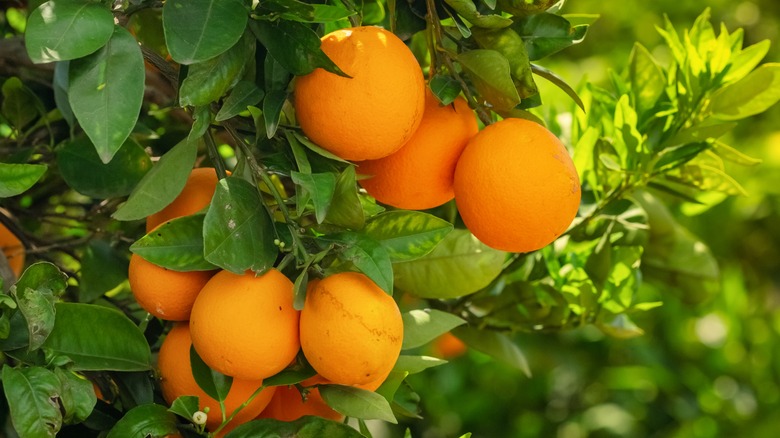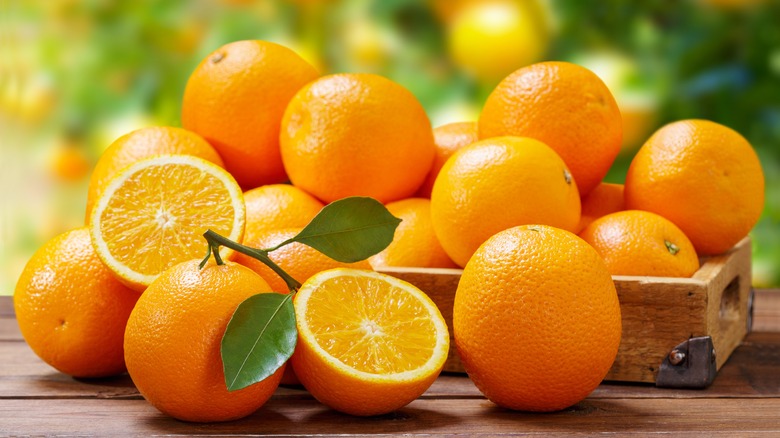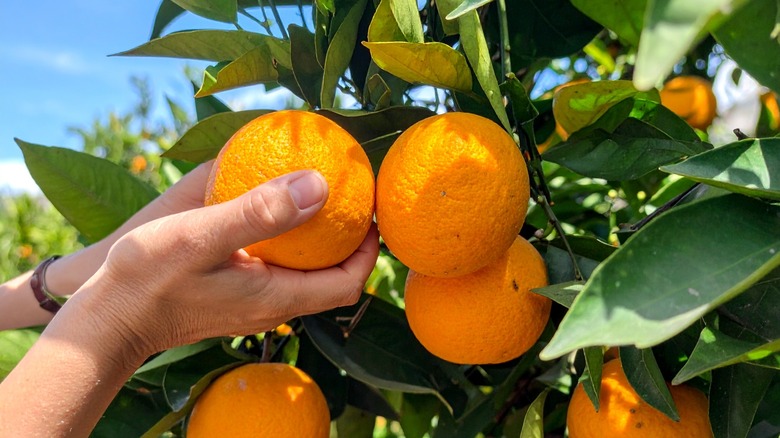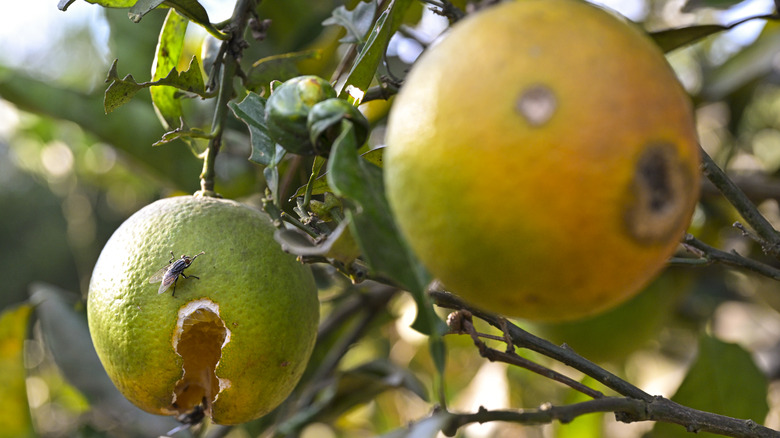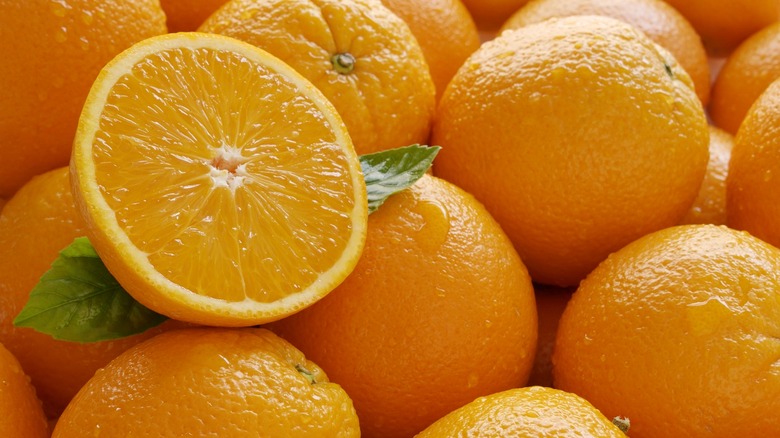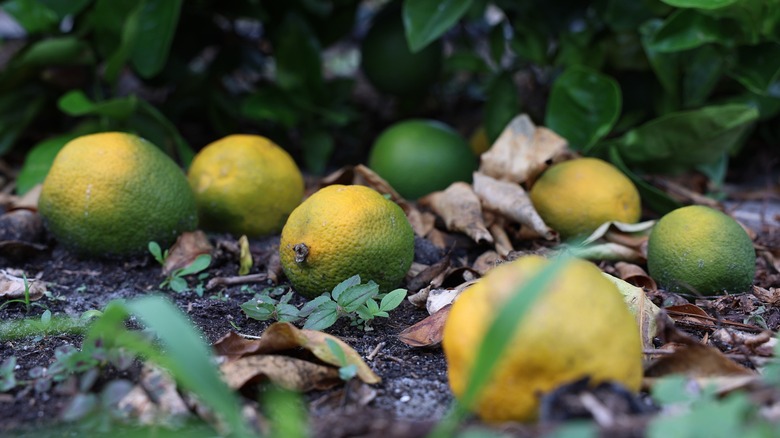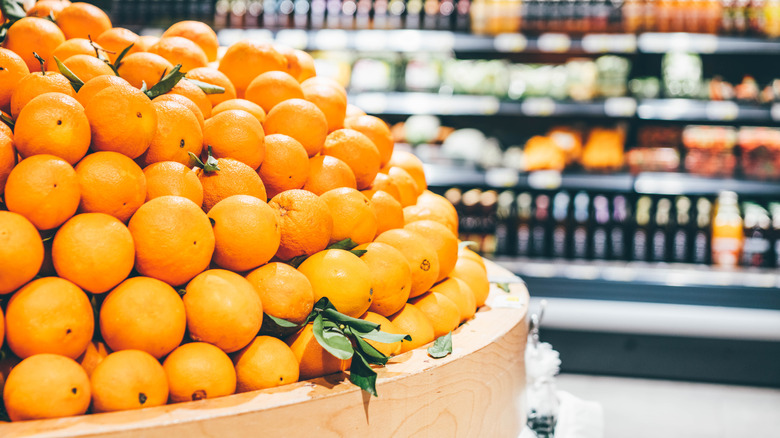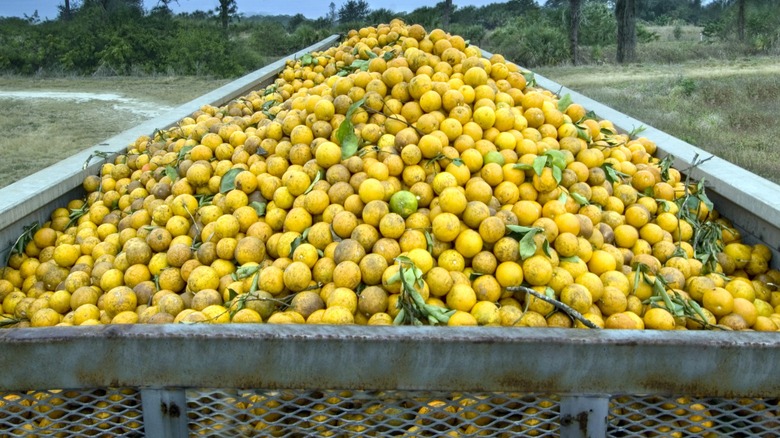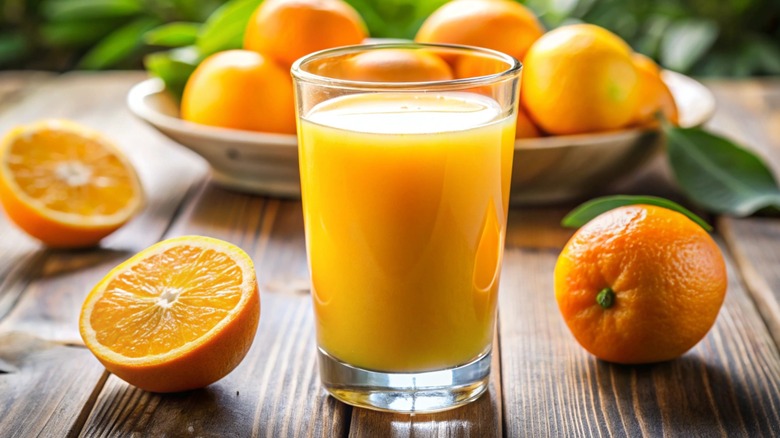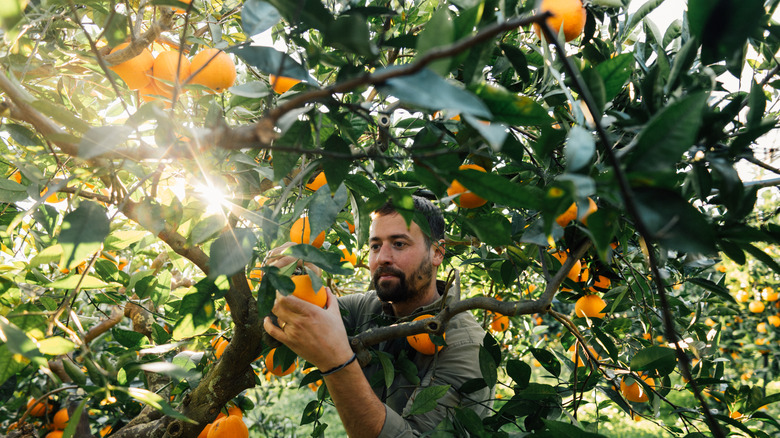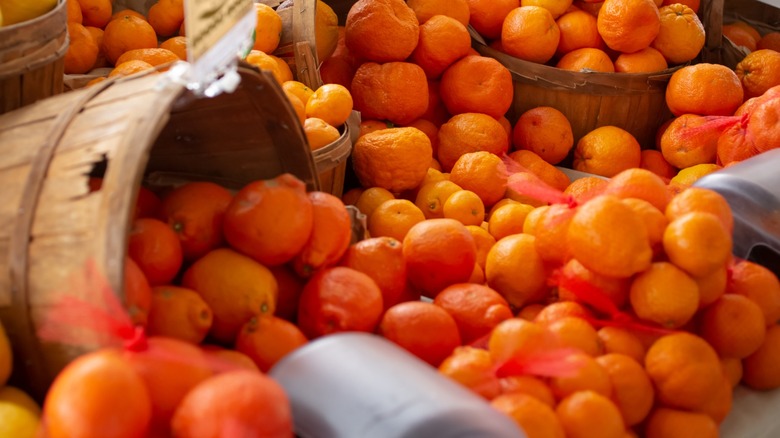The Dramatic Fall Of Florida Oranges
For decades, Florida has been the state most associated with oranges, from the annual Orange Bowl — the second-oldest college football bowl game still played in the U.S. — to ad campaigns pushing Florida orange juice. For a while, it seemed like you couldn't get away from T.V. ads extolling the virtues of Florida oranges and orange juice, as if there was only one source that could satisfy the country's appetite for sweet citrus.
But everything changed when Y2K came about, challenging Florida's status as the orange capital of America. A confluence of extreme weather, expansive development, and citrus scourge has drastically reduced the output for Florida orange growers. All of it has led to a 25-year decline in crops and hamstrung the industry, leaving farmers who've staked their livelihoods on this formerly fertile sector twisting in the wind.
The details behind the rolling decline of Florida oranges provide an object lesson in how precarious farming can be in the 21st century. But despite the pile-on of unfavorable factors derailing this once-premium American fruit-growing region, there's hope that you'll still be find Florida oranges in red mesh bags, if leaders can agree that the juice is worth the squeeze.
The state was once one of the largest orange producers in the U.S.
There was a time when you couldn't escape the presence of Florida oranges. Prior to 2014, the state was responsible for growing 70% of America's best-loved citrus fruit. Oranges from the region had more weight and held more juice than similar fruit from the West Coast, making Florida oranges prime targets for juicing companies.
But the rise of Florida as the orange capital of the U.S. wasn't without challenges. A huge freeze in 1895 set the industry back and reconfigured the map of which regions were prime for grove regrowth. By 1925, the renewed citrus growing sector was drawing in $30 million and moving around 10 million boxes of oranges every year.
A report from the Florida Department of Citrus stated that among all citrus commerce, oranges represented $3.3 billion in revenue and 15,000 jobs at one point. By the 2023-2024 season, the estimated value for all of Florida's citrus fruit before being picked was $221 million — the lowest total since the 1919-1920 season and allowing California to take the lead as the state that grows the most oranges.
Production has dropped by 92% in the past two decades
The 2000s have proven to be a rough era for Florida orange production, and not in a small way. Numbers have descended radically, with 92% fewer oranges being grown and harvested in Florida groves. Freezes and hurricanes offered challenges from the 1960s through the 1980s, though the crops were always able to resurge, drawing to peak production in the 1990s.
The rolling impact of these natural forces has resulted in making the growing season between 2024 and 2025 the lowest production period for the Florida citrus industry in nearly a century. For the orange growers, this meant a 32.7% drop from the previous season. The last time production was so low was the 1919-1920 growing season.
To better understand why it may be hard to find Florida oranges this season, it might help to visualize what such a huge drop in orange production means. Florida producers turned out 240 million boxes of oranges at the industry's high point in the late-1990s. For the 2024-2025 growing season, the count had sunk to only 17 million boxes. When you realize those oranges are meant for both domestic and international business, it's easy to see how far the Florida orange industry has fallen.
Citrus greening disease is plaguing orange trees
The most ominous of the influences that have dropped Florida orange production to all-time lows is an invasive disease, scientifically called Candidatus Liberibacter asiaticus, but better known to growers as citrus greening disease. The first presence of the organism was found in Florida in 1998; by 2005, the disease was in full effect. In a 2019 survey conducted by University of Florida's Institute of Food and Agricultural Sciences, 57% of growers reported that 100% of their trees had been infected, with another 24% of growers experiencing an infection rate between 80% and 99%.
How does citrus greening negatively impact orange growth? An insect called an Asian citrus psyllid that survives by eating leaves and stems of citrus trees delivers the troubling bacteria to the tissues of the trees. Once the bacteria take over, the infected tree will produce misshapen green fruit that falls from the tree before it ripens. The degraded oranges also end up being sour instead of sweet. Unfortunately, the disease is fatal, leading to the death of the tree within years of the infection.
To combat the disease, scientists at the University of Florida are turning to genetic modification. By inserting a gene that produces protein capable of killing baby Asian citrus psyllids, the tree can fend off the invasive species. Experiments continue to find a similar process for killing adult psyllids. A potential $200 million investment proposed by the state senate may help, but experts say it would still take at least four years before viable fruit returns.
Citrus acreages have been cleared to accommodate population growth
As residents from around the world discover the myriad benefits of living in the Sunshine State, Florida's buildable land has become a hot commodity. From 2010 to 2022, the state saw a population increase of 3.4 million people. As of 2022, the state's population growth was the fastest in the U.S., making it the country's second most-valuable housing market, and pushing New York to third place.
Rather than toiling away and going broke trying to make oranges grow like they used to, many grove owners are taking the money and turning over their land to developers. The result has been a loss of more than half the state's orange-growing land between 2000 and 2023. One grower sold his 47-acre grove to a home developer for $6 million; oranges hadn't been produced there since 2004, which makes the buyout a lifeline that lets stymied farmers move on with their lives. In addition to housing, former groves are also becoming the sites of solar farms — enough for Florida to have the highest number of installations of any state for the third quarter of 2023.
Though the population boom appears to be retracting as of 2024, there are still plenty of residents taking up space in the state. As long as orange growth struggles, groves are likely to continue being repurposed for more profitable housing development.
Powerful hurricanes have decimated groves
Of course, there are hurricanes, one of Florida's best-known and most destructive features. Most groves are positioned on the southern two-thirds of the peninsula, and there isn't much that can be done to protect the open land required for growing oranges from heavy winds. Trees that produced oranges dependably for years have been reduced to tatters, upending the potential for future crops. The result is an entire industry subject to the whims of the weather, which is growing ever-more precarious as the altered climate advances in dire ways.
Not every hurricane has delivered the same crushing blows to Florida; three in particular have set the orange industry in the state back far more than the others. The first was Hurricane Irma in 2017, which resulted in $760 million in citrus grove damages. It was five years before Hurricane Ian delivered a gut punch to the Florida orange harvest in 2022. Only two years later, Hurricane Milton blew through to undo the modest rebuild farmers had been able to achieve and causing another $190 million-plus in orchard destruction.
The combined impact and relatively short span between compounded the damage that ranged from defoliation of limbs to entire trees uprooted. With the unpredictability of future hurricane seasons and potential storm strength, stability will be uncertain even if growers are able to reestablish their groves before the next big one hits.
Tariff wars haven't helped the situation
As of 2022, Florida was exporting $630 million of oranges to regions including Japan, Canada, and the European Union, reaping a considerable income for the state and its agricultural industry. But when the current administration began levying tariffs on just about every sector, the state's orange income took a hit. Farmers paying more for equipment and fertilizer are spending more and making less, dragging down their already-diminishing return.
Though the come-and-go tariffs grow more capricious every month, the ultimate impact for Florida orange growers has been undeniably negative. Canada alone is now under a 35% tariff rate, up from the former 25%. With reciprocal tariffs applied by the affected countries, the drawdown in fruit and juice being purchased from Florida growers will result in losses even if orange production can sustain.
Soybean farmers feeling the pinch are already appealing to the federal government for relief, signaling the possibility of a bailout in the near future. If that happens, Florida orange growers may have grounds to plead their case for assistance to see them through for the short term, though it's not likely to counter the losses from non-tariff challenges.
Monetary losses for growers are in the billions
It's not hard to imagine what so many strikes against the Florida orange industry means in terms of dollars and cents. From 2006 to 2011, citrus greening of juice oranges represented $1.36 billion in revenue loss, with more than 2,000 jobs lost. By 2012, those numbers had grown to around $3.63 billion, with more than 6,600 jobs lost.
Hurricanes are obvious loss leaders, too, with Milton causing in the neighborhood of $23 to $55 million in citrus industry damages in 2024. With rebuilding costing growers precious funds and a lack of crops reducing potential sales, orange farmers have been hit with a financial double-whammy that would take several hearty growing seasons to recover from.
Even if a resurgence were possible, the number of acres still operating in the orange growing business continue their rapid decline. After dropping by 17% as the 2024-2025 season began, acreages have taken another 24% dive at the start of the 2025-2026 season. Obviously, fewer acres means less fruit, and less fruit means less money — and that's if the produce is viable when harvest time arrives.
The FDA may alter the sweetness of Florida orange juice to compensate
In the 20th century, Florida orange juice was essentially its own brand, allowing growers an additional revenue stream for their plentiful crops. But with orange stock dwindling, the orange juice sector has also been feeling the squeeze; if you can't produce bountiful oranges as food, you obviously can't produce them as fodder for juice, either.
Compounding the poor growing situation is the ever-decreasing demand for orange juice as a beverage. One of the reasons Americans have stopped drinking orange juice: Concerns over sugary beverages seem to have shifted consumer interest toward less-sweet alternatives. Prices for orange juice have also climbed due to the diminishing stock, causing even devoted drinkers to think twice.
In an effort to reduce the burden carried by Florida orange production, the FDA could potentially lower the Brix, the sweetness factor of orange juice, from 10.5 to 10. A change like this isn't expected to compromise the flavor or nutritional content of the juice. What it will do is allow all oranges grown in the region to be utilized, giving growers the opportunity to continue selling their fruit. Juice companies that get most of their oranges from Florida — biggies like Tropicana — could continue to feed funds to the growers in exchange for fresh, viable fruit.
Farmers are asking the state for help
There's no question that a situation as stark as the Florida orange downfall requires government intervention. The first line of defense for growers: appealing to the state for much-needed financial aid. The 2024-2025 budget featured $29 million dedicated to mitigating citrus greening via tech innovations and research, as well as $9 million devoted to marketing to boost citrus sales.
Additionally, the budget for the upcoming 2025-2026 growing season features an aid package of $124.5 million to manage groves, install trees that resist greening, and shore up existing trees to stimulate production. The catch-22 seems to be that if the state doesn't have oranges to sell, no marketing budget will be big enough. There's also the question of whether solutions will come in time. With many growers facing the life-altering decision of sticking it out or shutting down, the Florida farmers that remain may not be able to bolster the struggling market.
A comeback may be challenging, but it isn't entirely impossible
It may have taken more than two decades for the full brunt of Florida's orange-growing woes to be felt, but that doesn't mean the situation is permanent, or entirely hopeless. An antibiotic called oxytetracycline may be helpful in getting greening under control, giving the search for a real cure time to unfold. Another possible solution in the works involves a system that would pump antigens into trees to battle the scourge. While progress continues on long-term solution, real-time fixes that use chemicals to strengthen trees and prevent fruit from dropping prematurely have proven promising.
The clock is ticking though, and family farms may not have the luxury of waiting for a fix. Even with potential solutions, not every enterprise will have the funds to implement it on their land, which means more governmental intervention will be necessary. There's no predicting how many farms will have been sold off or simply shuttered when owners run out of funds and wherewithal to keep going. If another hurricane plows through or a freeze sets in to lock up operations, there may be no recovering. In the meantime, Florida oranges keep hanging on.
